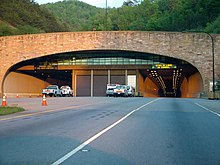Cumberland Gap Tunnel
 |
|
| Overview | |
|---|---|
| Location | Tennessee-Kentucky state line underneath Cumberland Gap |
| Coordinates | 36°35′53″N 83°40′34″W / 36.59806°N 83.67611°WCoordinates: 36°35′53″N 83°40′34″W / 36.59806°N 83.67611°W |
| Route |
|
| Start | Cumberland Gap, Tennessee |
| End | Middlesboro, Kentucky |
| Operation | |
| Opened | October 18, 1996 |
| Toll | none |
| Technical | |
| Length | 0.9 miles (1.4 km) |
| No. of lanes | 4 |
| Tunnel clearance | 30 ft (9.14 m) |
The Cumberland Gap Tunnel is a tunnel that carries U.S. Route 25E under Cumberland Gap National Historical Park near the intersection of Kentucky, Tennessee, and Virginia. According to United States Geological Survey maps of the area, the tunnel does not enter Virginia. It is one of only two mountain vehicular tunnels in the United States that cross a state line, the other being the East River Mountain Tunnel on Interstate 77 between Virginia and West Virginia.
The tunnels consist of two tubes, each 4,600 feet (1,402 m) long. Each tube carries two lanes of traffic. An "illumination zone" is included at each portal to allow drivers' vision to adjust to the lower light level in the tunnel. The speed limit in the tunnel is 45 mph (70 km/h); lane changes are prohibited. Trucks carrying Class 1 hazardous cargo (i.e., explosives) are prohibited from using the tunnels, while other hazardous cargo and wide loads are directed to a pull-off area and sent through one at a time with an escort. The overall construction cost, including the four-lane approach roads at both portals, was $280 million.
The tunnel replaced a 2.3-mile (3.7 km) stretch of U.S. 25E between Middlesboro, Kentucky and Cumberland Gap, Tennessee that became known as "Massacre Mountain" due to the large number of travelers killed on the twisting mountain road over the Cumberland Gap pass.
Even in the late 1970s, road traffic through the park had increased to the point of being unmanageable, and the project to replace the surface road began in 1980. However, construction did not begin until 1991. Early on, it was decided that widening the existing surface road to four lanes would adversely affect the historically sensitive areas in the park, making a tunnel the only viable choice. As a part of the plan, the existing road through Cumberland Gap has been removed and restored as a wagon path similar to that used by early 19th-century travelers.
...
Wikipedia
